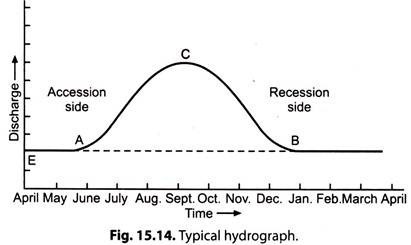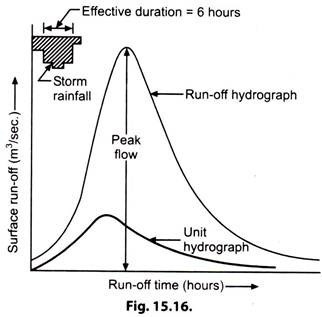ADVERTISEMENTS:
In this article we will discuss about the hydrograph representing run-off of rainfall, with the help of suitable diagrams.
Hydrograph is defined as a graph showing discharge (run-off) of flowing water with respect to time for a specified time. Discharge graphs are known as flood or run-off graphs. Each hydrograph has a reference to a particular river site. The time period for discharge hydrograph may be hour, day, week or month.
Hydrograph of stream of river will depend on the characteristics of the catchment and precipitation over the catchment. Hydrograph will access the flood flow of rivers hence it is essential that anticipated hydrograph could be drawn for river for a given storm.
ADVERTISEMENTS:
Hydrograph indicates the power available from the stream at different times of day, week or year.
Typical hydrographs are shown in Figs. 15.14 and 15.15.
The Unit Hydrograph:
ADVERTISEMENTS:
The peak flow represents a momentary value. Therefore the peak flow alone does give sufficient information about the run-off. It is necessary to understand the full hydrograph of flow. Introduction of unit hydrograph theory in 1932 made it possible to predict a runoff hydrograph corresponding to an observed or hypothetical storm.
The basic concept of unit hydrograph is that the hydrographs of run-off from two identical storms would be the same. In practice identical storms occur very rarely. The rainfall generally varies in duration, amount and areal distribution. This makes it necessary to construct a typical hydrograph for a basin which could be used as a unit of measurement of run-off.
A Unit hydrograph may be defined as a hydrograph which represents unit run-off resulted from an intense rainfall of unit duration and specific areal distribution.
ADVERTISEMENTS:
The following steps are used for the construction of unit hydrograph:
1. Choose an isolated intense rainfall of unit duration from past records.
2. Plot the discharge hydrograph for outlet from the rainfall records.
3. Deduct the base flow from stream discharge hydrograph to get hydrograph of surface run-off.
4. Find out the volume of surface run-off and convert this volume into cm of run-off over the catchment area.
5. Measure the ordinates of surface run-off hydrograph.
6. Divide these ordinates by obtained run-off in cm to get ordinates of unit hydrograph.
Thus for any catchment unit hydrograph can be prepared once. Then whenever peak flow is to be found out, multiply the maximum ordinate of unit hydrograph by the run-off value expressed in cm. Similarly to obtain run-off hydrograph of the storm of same unit duration multiply the ordinates of the unit hydrograph by the run-off value expressed in cm.
If the storm is of longer duration calculate the run-off in each unit duration of the storm. Then super-impose the run-off hydrographs in the same order giving a lag of unit period between each of them. Finally draw a summation hydrograph by adding all the overlapping ordinates. Generally the computations are done in a tabular form before the hydrograph is plotted.
ADVERTISEMENTS:
Fig. 15.16 is self-explanatory and shows how a run-off hydrograph is constructed from a unit hydrograph.
Limitations to the Use of Unit Hydrographs:
1. Its use is limited to areas about 5000 sq. kilometres since similar rainfall distribution over a large area from storm to storm is rarely possible.
2. The odd-shaped basins (particularly long and narrow) have very uneven rainfall distribution, therefore/ unit hydrograph method is not adopted to such basins.
3. In mountain areas, the areal distribution is very uneven, even then unit hydrograph method is used because the distribution pattern remains same from storm to storm.


